序章
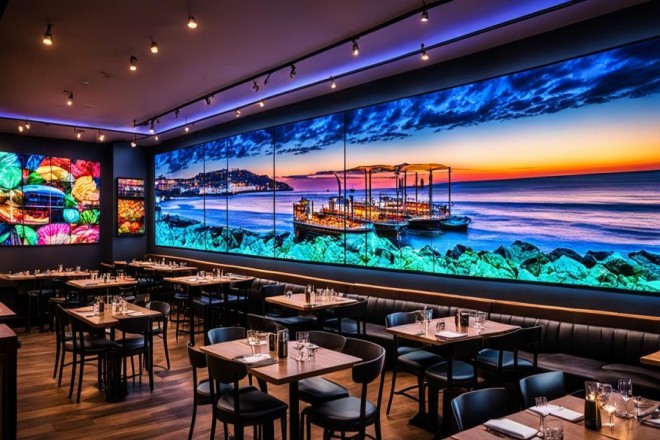
Imagine, on a busy street, how your restaurant can stand out from many competitors and instantly attract the attention of pedestrians. How can customers feel the unique atmosphere and be surprised immediately when they step into the restaurant? The answer may be right in front of you- the LED表示.
This article will be the magic key in your hand, taking you to explore how to use the modern technology of LED display to turn your restaurant into the most dazzling pearl on the street corner.
We will deeply analyze the unique advantages of LED display in attracting customers, enhancing brand image, and promoting consumer decisions, and provide a set of practical guides to teach you how to design, install, and maintain this “dynamic signboard” to make it a powerful weapon for your restaurant marketing.
1. Let's talk briefly about the application of LED displays in the catering industry
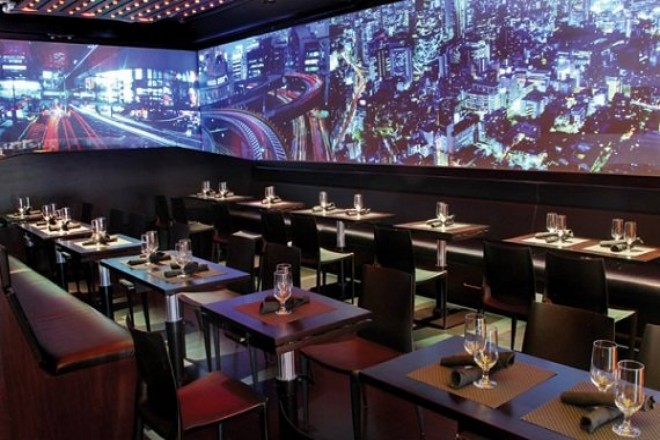
1) What is an LED display, and what are its “superpowers”?
Imagine that an LED display is like a magic canvas, but it is made up of thousands of small bulbs (LED lights). These bulbs can emit very bright light and have rich and varied colors, from bright red to fresh blue.
Most importantly, the content on this canvas is not static. It can play videos, animations, and even real-time updated information, just as vivid as your mobile phone screen.
Super bright “vision”: Whether it is a sunny day or a dimly lit night, the LED display can remain clearly visible, ensuring that passers-by can see the content at a glance.
Color “magician”: It can display countless color combinations, making the picture more vivid and attracting people’s attention.
Dynamic “dancer”: It supports the playback of various dynamic content, making the information display no longer monotonous but full of fun and vitality.
2). The “new favorite” of the catering industry-LED display
In the catering industry, LED display is like a versatile assistant that can work indoors and “adventure” outdoors.
Indoor installation: Inside the restaurant, it can be used to display menus, today’s specials, and holiday decorations or play relaxing music videos to create a comfortable dining atmosphere.
Outdoor installation: For restaurants facing the street, the LED display is like a huge billboard, attracting the attention of passers-by and telling them: “Hey, there is delicious food here!” Moreover, it is not afraid of wind and rain and can stick to its post no matter how the weather changes.
2. Three strategies for LED display to attract customers
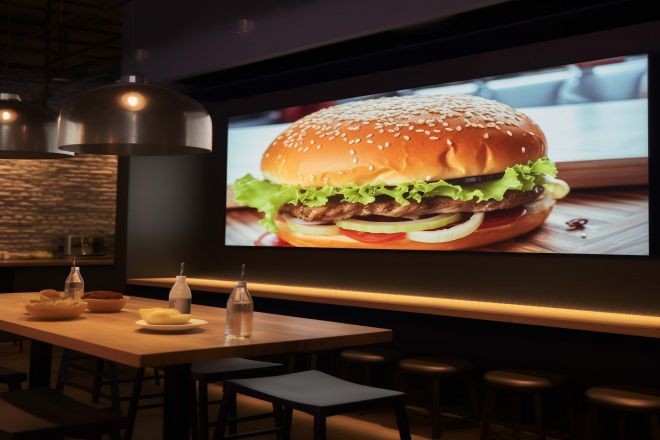
In the catering industry, LED display, as a modern information dissemination tool, can not only provide a rich visual experience but also effectively enhance the brand image of the restaurant and attract and retain customers. Here are some detailed and easy-to-understand strategies to help restaurants make full use of LED displays to attract customers.
1). Visually attractive design: make customers unforgettable at first sight
1.1). Dynamic image and video display:
- Food production process:
Through high-definition video, the cooking process of the restaurant’s signature dishes is displayed in real-time.
Customers can see with their own eyes how the ingredients are turned into delicious dishes. This visual enjoyment can stimulate their curiosity and expectations for food.
- High-definition pictures of special dishes:
Regularly update the restaurant’s special dishes pictures to ensure that customers can see new surprises every time they visit.
High-definition pictures can clearly show the color, plating, and details of the dishes, allowing customers to feel the charm of the food before tasting it.
1.2). Creative advertising design:
- Animation and gradient colors:
Use animation effects and gradient colors to design unique advertisements. These design elements can attract the attention of passers-by, making them stop and pay attention to the restaurant’s information.
- Brand element integration:
Incorporate the restaurant’s brand elements, such as logos, slogans, or special decorations, into the advertising design to enhance the brand image and leave a deep impression on customers.
1.3). Seasonal theme change:
- 祝祭的な雰囲気を演出する:
Adjust the content on the LED display according to the changes in festivals or seasons. For example, festive blessings and red envelope patterns can be displayed during the Spring Festival, and refreshing drinks and beach scenery can be displayed in summer to create a strong festive atmosphere.
- Frequency of theme change:
Change the theme regularly to keep it fresh, so that customers can feel the restaurant’s care and changes every time they visit.
2). Effectiveness of information communication: Let customers easily obtain the information they need
2.1). Menu display and promotion information:
- Real-time update of dishes:
Update dish information on the LED display in real time, including price, taste description and recommendation reasons. In this way, customers can understand the characteristics of the restaurant’s dishes at a glance and make choices quickly.
- Promotion of special offers:
Use LED display screens to promote special restaurant offers, such as discounts, gifts, or member-only offers. These activities can stimulate customers’ desire to buy and increase the restaurant’s sales.
2.2). Business hours and navigation guide:
- Clear display:
Clearly display the restaurant’s business hours and address information on the LED display screen, making it easy for customers to find the restaurant location and understand the business hours.
- Navigation assistance:
Provide simple navigation guides, such as nearby bus stops, subway stations or parking lots, to help customers easily find the restaurant.
ソーシャル メディアでのやり取り:
Customer evaluation display: Display customer reviews on social media on the LED display screen, allowing customers to see other customers’ dining experience and enhance the restaurant’s word-of-mouth communication.
- Photo wall:
Display photos taken by customers in the restaurant to create a warm and friendly atmosphere. At the same time, encourage customers to share their dining experience on social media to expand the restaurant’s influence.
3). Personalized experience: Let customers feel exclusive care
3.1). Customized welcome message:
- Weather and time care:
Send warm greetings to customers based on weather or time. For example, on rainy days, customers can be reminded to pay attention to anti-slip, and at night, they can send good night wishes.
- Holiday greetings:
Send holiday greetings to customers on specific holidays, such as the Spring Festival, Mid-Autumn Festival, etc. These blessings can make customers feel the care and attentiveness of the restaurant.
3.2). Reservation and waiting information display:
- Reservation information:
Display reservation information such as reservation time, table number, and customer name on the LED display. In this way, customers can clearly understand their reservation status and avoid confusion and misunderstanding.
- Waiting time:
For customers who need to wait, the waiting time can be displayed on the LED display, and some entertainment content, such as small games, music videos, etc., can be provided. These entertainment contents can reduce customers’ waiting anxiety and enhance their dining experience.
3.2). Customer interactive games:
- Guess the dish game:
Display some pictures or descriptions of dishes on the LED display, and let customers guess the name or taste of the dish. Customers who guess correctly can get small gifts or coupons as rewards.
- Raffles:
Hold raffles during peak dining hours or specific time periods, allowing customers to participate in the raffle by scanning the QR code. This interactive game can increase the entertainment and fun before dining, allowing customers to enjoy food while getting surprises.
3. How to implement the strategy of attracting customers with LED display screens
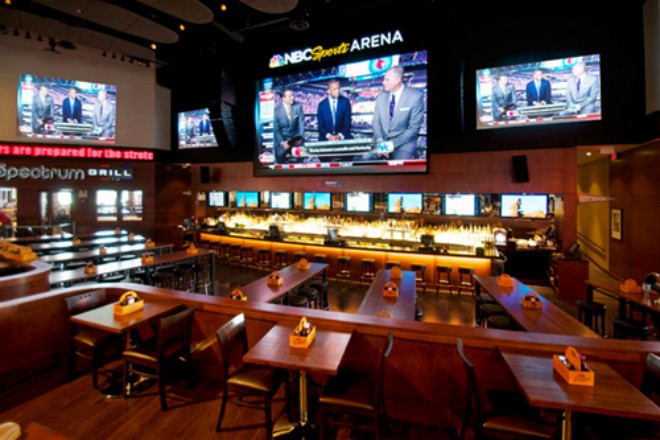
In the catering industry, LED display screens are an efficient and intuitive promotional tool that can help restaurants attract customers and enhance their brand image.
To ensure that LED display screens can play the most effective role, the following is a detailed and easy-to-understand implementation step, covering demand analysis, equipment selection and installation, content production and management, maintenance, and monitoring.
1). Demand analysis: clarify goals and positioning
1.1). Determine the target audience and display the purpose
Target audience: First, you need to clarify which group of people your LED display screen is mainly aimed at. Is it passers-by, customers in the restaurant, or both? Understanding the characteristics and preferences of the target audience will help you design content that better meets their needs.
Display purpose: clarify what content your LED display screen is mainly used to display. Is it to increase brand awareness, promote special offers, display food features, or other purposes? Clear goals will guide your subsequent content production and display strategies.
1.2). Evaluate installation location and visibility
Installation location: Choose a location that can maximize the viewing effect of the target audience. Consider factors such as crowd density, sight height, and obstructions to ensure that the LED display can be clearly and intuitively displayed to the target audience.
Visibility: Ensure that the parameters such as 輝度, color, and contrast of the LED display can adapt to the surrounding environment to avoid affecting the viewing effect in strong light or dark light environments. At the same time, consider the size of the screen and the viewing distance to ensure that the content is clear and readable.
2). Equipment selection and installation: Ensure efficient and stable operation
2.1). Screen size and 解決 considerations
Screen size: Select the appropriate screen size according to the installation location and viewing distance. Ensure that the screen is large enough to attract the attention of the target audience; at the same time, avoid being too large to cause the content to be too dense, affecting the viewing experience.
Resolution: Choose a high-resolution LED display to ensure the clarity and delicacy of the content. A high-resolution screen can present more details and improve the viewing effect.
2.2). Installation method and protective measures
Installation method: Select the appropriate installation method according to the installation environment and needs. Common installation methods include wall-mounted, column-mounted, embedded, etc. Ensure that the installation method is stable and reliable to avoid safety hazards.
Protective measures: Consider the protection level of the LED display to ensure that it can adapt to various harsh environments. For example, waterproof, dustproof, and impact-proof protective measures can extend the service life of the equipment and reduce maintenance costs.
2.3). Software and content management system selection
Software selection: Choose a content management system that is easy to operate and powerful. Make sure that the software can support content playback in multiple formats, such as video, pictures, text, etc.; at the same time, the compatibility and stability of the software should also be considered to ensure that the equipment can operate stably for a long time.
Content management system: Choose an easy-to-use and comprehensive content management system that can help you easily upload, edit and play content. Make sure that the system supports functions such as remote control and timed playback to improve management efficiency.
3). Content production and management: Improve attractiveness and interactivity
3.1). Collaborate with a professional design team or learn design software by yourself
Professional design team: If conditions permit, you can seek help from a professional design team. They have rich design experience and creative ability and can tailor LED display content that meets the characteristics and needs of the restaurant for you.
Self-learning design software: If you are interested in design and have a certain foundation, you can learn design software by yourself. Through learning and practice, you can gradually master the design skills and make your own content that matches the characteristics of the restaurant.
3.2). Update content regularly to keep it fresh
Content update: Update the content on the LED display screen regularly according to the restaurant’s activities and seasonal changes. Make sure the content is fresh, interesting, and attractive and can continue to attract the attention of the target audience.
Content diversity: Try to use a variety of formats and content types, such as videos, pictures, text, etc., to enrich the display effect. At the same time, the interactivity and fun of the content should also be considered to increase the audience’s participation and stickiness.
3.3). Use data analysis to optimize the display effect
Data collection: Collect audience feedback data on the content of the LED display screen through data analysis tools. Including indicators such as viewing time, click-through rate, conversion rate, etc., to understand the audience’s preferences and preferences for the content.
Data analysis: Analyze and interpret the collected data. Find out which content is popular and which content needs to be improved; at the same time, pay attention to the audience’s behavior patterns and consumption habits in order to more accurately position the content and marketing strategy.
Optimization strategy: Adjust the content strategy based on the results of data analysis. Optimize content layout, color matching and interactive methods, etc. At the same time, we should also pay attention to the development of new technologies and new trends, and constantly try and innovate to improve the display effect.
4. BIBILED's successful case sharing
1). South African children’s restaurant outdoor LED display case
- Product category: 屋外用 LED ディスプレイ
Outside a children’s restaurant in South Africa, a 3.84m x 1.92m P5 outdoor LED display has become a highlight to attract customers. The display uses advanced P5 pixel spacing technology to ensure high clarity and fineness of the image and can present a satisfactory visual effect even in outdoor environments.
The main purpose of installing this display in the restaurant is to play children’s favorite cartoons and videos to attract the attention of children and their parents, thereby increasing the restaurant’s customer flow. This strategy has achieved remarkable results.
Many children are interested in the content on the display and frequently invite their parents to dine together. The display not only brings a steady stream of customers to the restaurant but also creates a joyful and lively dining atmosphere, which is deeply loved by parents and children.
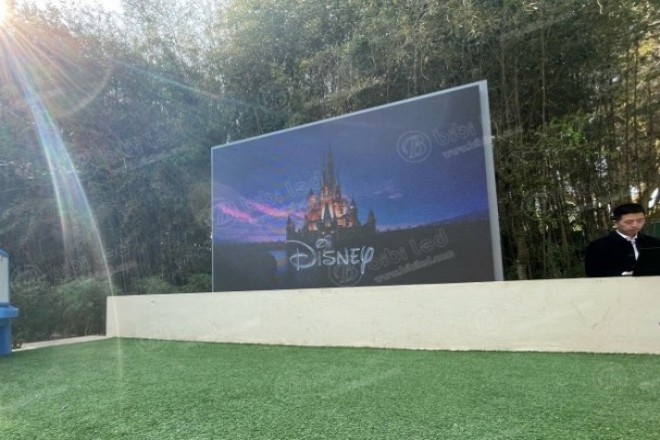
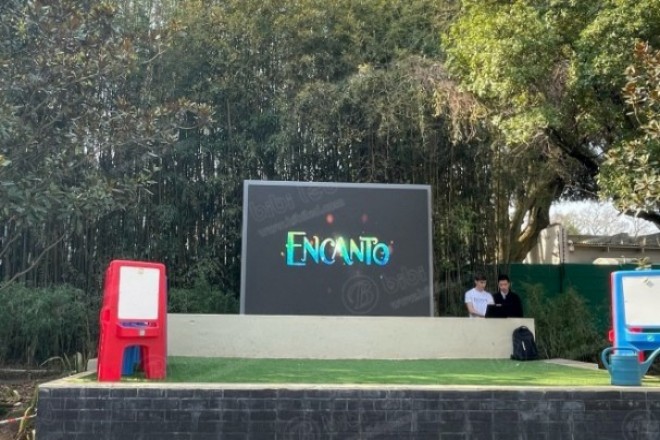
2). Polish restaurant indoor LED display case
Product category: 屋内用 LED ディスプレイ
Quality inspection link: Please click here
In a restaurant in Poland, a 3.84m x 1.44m P2 GOB indoor LED display was cleverly installed on the wall and became part of the restaurant’s interior decoration. This display uses GOB (Glass On Board) technology, which has higher stability and reliability and can maintain excellent display effects in various complex environments.
The restaurant uses this display to display its own various delicacies, and through exquisite pictures and vivid videos, customers can have an intuitive understanding of the dishes before ordering.
In addition, the display also bears the heavy responsibility of setting off the atmosphere of the restaurant, creating a warm and romantic dining environment by playing soft background music and dynamic light and shadow effects.
As the restaurant expected, the use of this LED display is very good. It not only improves the customer’s ordering experience but also significantly improves the restaurant’s brand image and popularity. Many customers said after dining this, display brought them a brand new dining experience and left a deep impression on them.
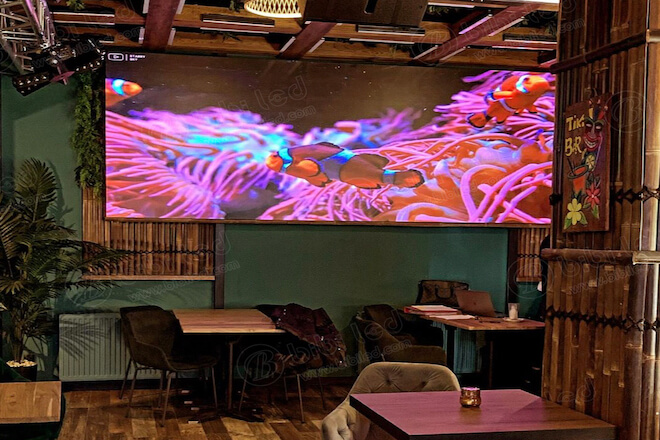
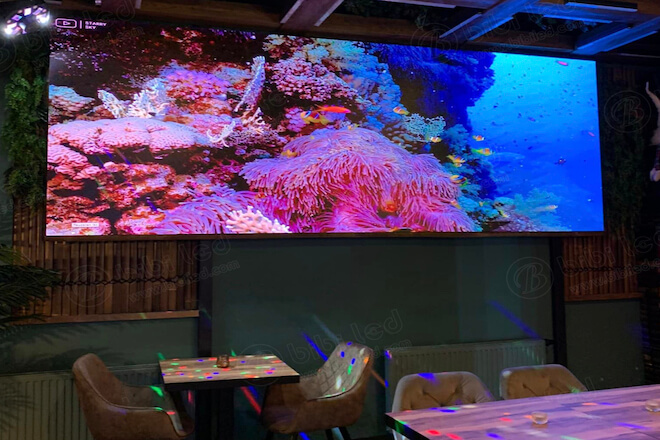
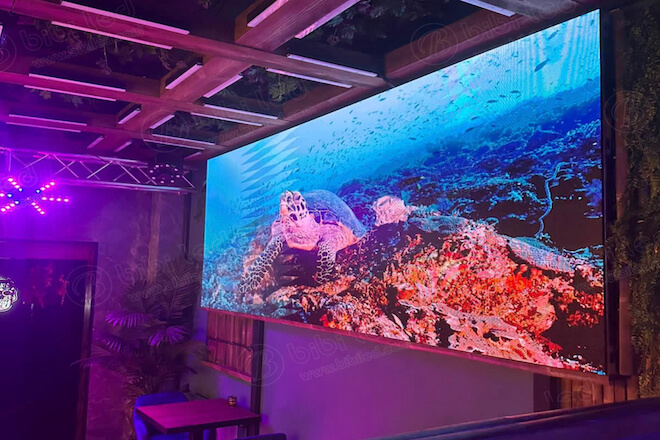
結論
In summary, as a modern technology product, the application of LED displays in the catering industry has great potential and value. Through careful planning and creative design, restaurants can use LED displays to display special dishes, promote promotions, and create a dining atmosphere, thereby attracting customers’ attention and enhancing brand influence.
At the same time, the real-time update capability and easy maintenance of LED displays also enable restaurants to keep up with market trends, adjust marketing strategies in a timely manner, and maintain competitive advantages.
Finally, if you want to learn more about LED displays, please get in touch with us.
